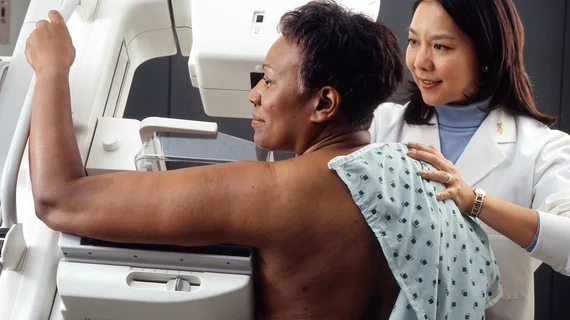Breast self-examination may help address imaging disparities in Black, Latina populations
Breast self-examinations may help to address mammography disparities in the Black and Latina populations, according to a new analysis published Friday.
Current guidelines out of the American Cancer Society and USPSTF do not recommend this practice. But these recommendations assume that women have regular access to breast imaging services, researchers noted in Clinical Imaging.
Exploring whether such self-exams could help reduce disparities, Zi Zhang, MD, and colleagues found eye-opening early results. In particular, minority women who presented with self-detected breast cancer were “significantly” more likely to have invasive ductal carcinoma and larger tumor size when masses were later examined via ultrasound.
“In our study, women who presented with self-detected breast mass also had higher rate of triple negative cancer,” Zhang, a breast imaging fellow with Penn Medicine, and colleagues wrote Oct. 24. “Thus, these women should be counseled about [breast self-examination] and/or [clinical breast examination] and encouraged to seek medical care early if they experience a change. Therefore, community outreach with BSE training and complimentary CBE programs may be important to improve early cancer detection in the underserved minority population.”
To reach their conclusions, Zhang et al. analyzed data from women newly diagnosed with breast cancer between 2016 and 2018 at a single inner-city hospital, pinpointing 59 new cases. Of those, 58% were Black, 34% were Latino while the other 8% were another race. About 61% presented with a self-detected breast mass, and only 36% had previously been screened via mammography (compared to a national average of 65%).
For those presenting with a mass, the odds of having a prior mammogram were about 78% lower. And the chance of having invasive ductal carcinoma was more than four times higher, compared to women presenting without a mass, the authors noted.
The analysis has several limitations, including its retrospective nature and missing data related to socioeconomic status, insurance coverage and education. But Zhang et al. believes this topic warrants further investigation.
“Future study is needed to evaluate whether supplemental screening methods, such as [breast self-examination] and/or [clinical breast examination], can help to improve breast cancer awareness and early breast cancer detection in minority women with limited access to care, and such disparities should be considered by organizations when creating screening guidelines,” they concluded
Read more in Clinical Imaging here.

